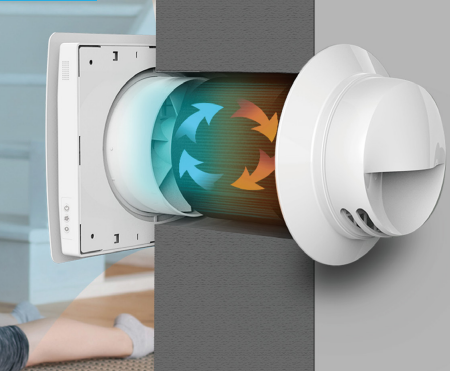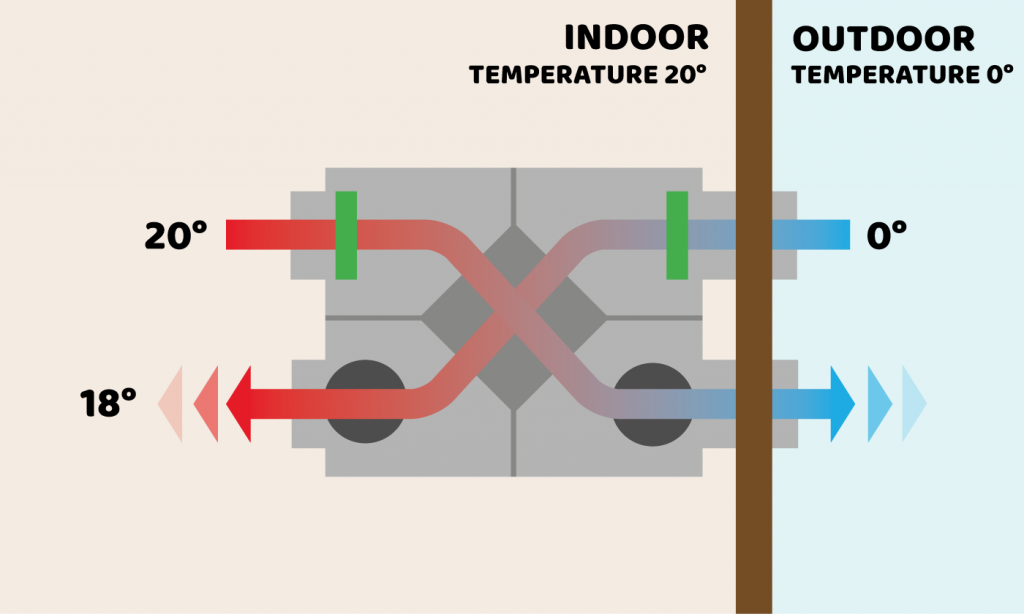Common Mistakes About HRV That Homeowners Should Know
Revealing the Trick Advantages and Uses of Heat Recovery Ventilation in Lasting Layout
Heat Recovery Ventilation (HRV) systems play a vital duty in lasting layout. They help with a continuous exchange of stagnant indoor air with fresh outdoor air, substantially enhancing indoor air top quality. Additionally, HRVs add to energy performance by redeeming heat from tired air, which can reduce utility prices. Recognizing the complex benefits and applications of HRVs discloses their importance in modern-day style. What other advantages do these systems supply in the pursuit of sustainability?
Recognizing Heat Recovery Ventilation Systems
Heat recovery ventilation (HRV) systems are created to boost indoor air top quality while minimizing energy loss. These systems utilize a mechanical ventilation technique to exchange stale interior air with fresh exterior air, making sure a constant supply of tidy air. By capturing warm from the exhaust air, HRVs prerequisite inbound air, lowering the demand on home heating and cooling systems. This process not only improves thermal comfort however also adds to energy performance in household and business buildings. Furthermore, HRV systems assist manage moisture degrees and decrease interior pollutants, advertising a healthier living environment. Their critical execution is crucial for achieving sustainable layout objectives, as they use an equilibrium between energy preservation and owner well-being.
Just How HRV Solution Job
While numerous may know with air flow systems, understanding just how warmth healing air flow (HRV) systems operate is crucial for appreciating their benefits. HRV systems work by exchanging stagnant interior air with fresh exterior air while moving heat in between the two streams. This procedure occurs in a warmth exchanger, where heat from the outbound air heats the inbound air during colder months, lessening power loss. Conversely, in warmer months, the system can cool inbound air making use of the cooler outgoing air. HRVs are outfitted with followers to help with air movement and filters to remove particulates, making certain a constant, well balanced ventilation procedure. This cutting-edge layout not just improves energy performance but likewise adds to preserving a comfy indoor setting.
Enhancing Indoor Air Quality
Indoor air top quality can significantly impact health and wellness and well-being, making efficient ventilation vital in modern-day homes. Heat Recovery Ventilation (HRV) systems play a crucial role in preserving interior air high quality by constantly trading stagnant indoor air with fresh exterior air. This procedure not just decreases air-borne contaminants but also decreases moisture levels, which can lead to mold development and breathing problems. HRV systems filter inbound air, removing irritants and particulates, therefore offering a much healthier living environment. Furthermore, these systems help get rid of odors and unstable natural substances (VOCs) frequently found in household products. By making sure a consistent flow of clean air, HRV systems add to a total improved indoor atmosphere, advertising convenience and wellness for occupants.
Energy Effectiveness and Expense Financial Savings
Energy performance stands apart as a considerable benefit of Heat Recovery Ventilation (HRV) systems. By catching and recycling the heat from tired indoor air, HRVs decrease the energy needed for home heating inbound fresh air, resulting in minimized energy usage. This performance equates into reduced utility costs, providing significant expense financial savings for homeowners and companies alike. Furthermore, HRV systems commonly get power efficiency incentives and rebates, even more improving their economic allure. In time, the initial financial investment in HRV technology can result in a positive return on financial investment via reduced power costs. Consequently, the combination of HRV systems not just advertises lasting style yet likewise provides a practical option for accomplishing lasting power savings and economic advantages.
Environmental Benefits of HRV

A wide range of ecological advantages occurs from the execution of Heat Recovery Ventilation (HRV) systems. By effectively moving warm from exhaust air to incoming fresh air, HRVs substantially lower the energy required for heating and cooling spaces. This energy performance converts to reduce greenhouse gas exhausts, adding to a decline in the general carbon impact of buildings. In addition, HRV systems enhance indoor air quality by continually distributing fresh air, thus decreasing the focus of interior pollutants and allergens. Furthermore, the reduction in power consumption help in saving all-natural resources, making HRVs a crucial element of lasting design. Generally, the environmental advantages of HRVs play an important function in promoting a much healthier earth and promoting environmentally friendly building techniques.
Versatile Applications in Modern Architecture
Heat recovery ventilation (HRV) systems are progressively being incorporated into both property and business architectural jobs. In domestic settings, HRVs enhance interior air top quality while making the most of energy effectiveness. In commercial spaces, these systems enhance air flow strategies, demonstrating their versatility in modern-day architectural applications.
Residential Projects Integration
While modern-day design progressively highlights sustainability, the integration of warm recuperation ventilation systems in domestic jobs has become a sensible service for boosting interior air high quality and power effectiveness. These systems successfully move warmth from exhaust air to incoming fresh air, reducing power loss and reducing heating or cooling demands. In new builds and retrofits alike, warmth recuperation air flow can be seamlessly integrated, supplying homeowners with a much healthier living setting while lowering energy expenses. Furthermore, with boosting awareness of ecological impacts, more engineers and home builders are acknowledging the lasting advantages of these systems. Consequently, warmth recovery ventilation has become a crucial element of sustainable residential layout, showcasing convenience and dedication to eco-friendly practices.
Business Spaces Optimization
As modern-day commercial areas evolve to meet the demands of sustainability and performance, the execution of warmth recovery ventilation systems emerges as a crucial strategy for maximizing indoor atmospheres. These systems facilitate the exchange of stale interior air with fresh exterior air while redeeming heat, substantially reducing energy intake. This not only improves comfort for owners however also helps in lowering functional expenses. Versatile applications can be observed in workplaces, retail areas, and universities, where air quality and temperature level control are critical. In addition, incorporating warm healing ventilation straightens with eco-friendly structure accreditations, additionally promoting environmental duty. Eventually, embracing such systems in business design not only contributes to sustainability objectives but additionally promotes healthier, a lot more effective spaces for users.
Incorporating HRV Into Sustainable Style Practices
Integrating warmth healing ventilation (HRV) systems right into sustainable style methods uses considerable benefits in power effectiveness and indoor air top quality. By utilizing HRV, developers can create affordable remedies that not only reduce energy intake however also boost the overall convenience of indoor environments. This positioning with sustainability goals settings HRV as a crucial component in modern-day architectural approaches.
Energy Performance Improvement
By incorporating warmth recovery air flow (HRV) systems into lasting style practices, architects and contractors can considerably boost power performance in modern-day building and constructions. HRV systems operate by capturing warm from outbound stagnant air and transferring it to incoming fresh air, minimizing the power needed for heating or cooling interior rooms. This process not just reduces reliance on traditional cooling and heating systems but additionally lowers general energy intake. On top of that, HRV systems can aid preserve a constant interior temperature, decreasing peak energy demands. By incorporating these systems, structures can attain substantial reductions in utility costs and carbon impacts, aligning with sustainability goals. Read More Here Inevitably, HRV modern technology represents a functional option for enhancing energy performance in the constructed atmosphere, advertising more accountable source use.
Indoor Air Quality Enhancement
How can heat recovery ventilation (HRV) systems add to remarkable interior air high quality in modern-day structures? HRV systems successfully exchange stale indoor air with fresh exterior air while recouping warm power, reducing temperature level changes. This process decreases the focus of interior contaminants, such as unstable organic substances (VOCs), irritants, and dampness, which can deteriorate air top quality and influence owner health and wellness. By preserving optimal moisture levels and ensuring a continuous supply of clean air, HRVs assist create a healthier interior setting. Additionally, these systems can be incorporated into sustainable design techniques, promoting energy performance along with boosted air quality. HRV Heat Recovery Ventilation. HRV technology plays a vital role in progressing general resident convenience and health in modern architectural layouts.
Affordable Design Solutions

Regularly Asked Inquiries
What Maintenance Is Needed for Heat Recovery Ventilation Equipments?

Maintenance for warmth recovery ventilation systems usually entails normal filter replacements, cleansing of heat exchangers, examination of followers and air ducts, and making certain proper drain. These tasks help keep efficiency and lengthen the system's lifespan over time.
Can HRV Equipments Be Set Up in Existing Structures?
Heat recovery ventilation systems can indeed be mounted in existing buildings. HRV Heat Recovery Ventilation. Retrofitting requires mindful preparation and analysis of the building's layout, making sure compatibility with existing systems while making best use of energy efficiency and interior air high quality
Exactly How Do HRV Systems Impact Sound Levels Inside?
HRV systems can influence interior sound levels by introducing sound from exterior sources via air flow. However, top quality installments typically include sound-dampening functions, lessening sound influence while giving reliable air exchange and keeping comfort inside your home.
Exist Any Downsides to Making Use Of HRV Equipments?
The drawbacks of utilizing HRV systems consist of possible high initial costs, maintenance obstacles, and the possibility of decreased interior air high quality if filters are sporadically changed, which might result in problems with humidity levels.
Just how Do I Select the Right HRV System for My Requirements?
Selecting the ideal warmth healing air flow system includes assessing details needs, such as developing dimension, climate, and power effectiveness goals. navigate to these guys In addition, reviewing system features, installation requirements, and maintenance considerations is essential for peak performance and fulfillment.